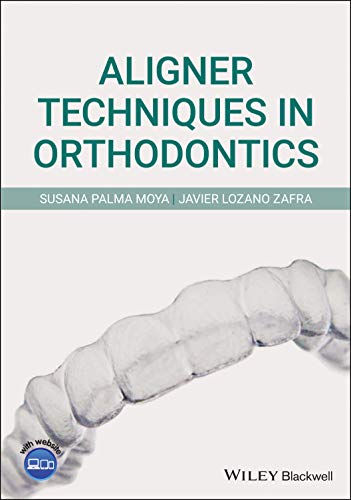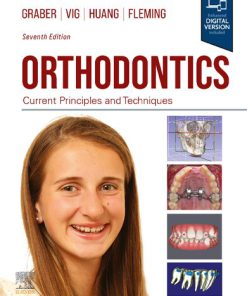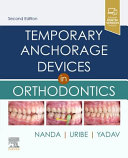Aligner Techniques in Orthodontics by Susana Palma Moya, Javier Lozano Zafra 9781119607236 111960723X
$50.00 Original price was: $50.00.$25.00Current price is: $25.00.
Aligner Techniques in Orthodontics Susana Palma Moya – Ebook Instant Download/Delivery ISBN(s): 9781119607236, 111960723X

Product details:
- ISBN 10: 111960723X
- ISBN 13:9781119607236
- Author: Susana Palma Moya, Javier Lozano Zafra
Aligner Techniques in Orthodontics
Primary: Practising orthodontists who are interested in aligner techniques
Secondary: General dentists who are interested in aligner techniques
Table contents:
1 History, Present and Future of Aligners
1.1 History of Clear Aligners
1.2 Origins of Align Technology
1.3 Early Clear Aligner Manufacturers
1.4 Align Technology Development
1.5 Current Situation and Future of Aligners
1.6 Promising Aligner Initiatives
1.7 Future of Clear Aligners
2 Basic Principles with Aligners
2.1 Forces
2.2 Engagement
2.3 Anchorage
2.4 Case Selection to Start with Aligners Technique
3 Why Invisalign?
3.1 Why Did We Begin Prescribing Invisalign in Our Practice?
3.2 Our Motivation
4 Patient Communication Skills
4.1 Invisalign Equates to Health, Wellness and Outstanding Results
4.2 Effective Patient Communication
5 Keys to Practice Growth
5.1 How to Get the Best Results with Invisalign
6 Patient Selection
7 Predictability of Movement
7.1 Treatments to Gain Familiarity with the Technique
8 Types of Treatments with Invisalign
9 Pillars of the Invisalign Technique
9.1 Aligners
9.2 ClinCheck Software
9.3 Attachments and Features of SmartForce
9.4 Auxiliary Techniques
9.5 Technician (CAD Designer)
10 Conventional Attachments
11 Clinical Preferences
12 Attachments Bonding and Interproximal Reduction
12.1 Bonding Attachments Protocol
12.2 Interproximal Reduction Procedure
13 Digital Workflow
13.1 Records
13.2 Creating a New Patient Record
14 ClinCheck Software
14.1 The Perfect ClinCheck Review in 10 Steps
14.2 Communication with the Technician
15 Treatment Monitoring and Appointments Protocol
15.1 Tracking Treatment Progress
15.2 Appointments Protocol for Invisalign Patient
16 Troubleshooting and Retention
16.1 Auxiliary Techniques
16.2 Finishing Techniques
16.3 Retention
17 Arch Length Discrepancies
17.1 Spacing
17.2 Crowding
18 Growing Patients
18.1 First Treatment
18.2 Teenage Patients
19 Transversal Problems: Symmetric and Asymmetric Expansion
19.1 Things to Consider in Expansion Cases
19.2 Symmetric Expansion
19.3 Asymmetric Expansion
19.4 Tips for Transversal Arch Compensation
20 Sagittal Discrepancies
20.2 Class II Cases
20.3 Class III
20.4 Dentoalveolar Protrusion Skeletal Class II
21 Vertical Problems
21.1 Open Bite
21.2 Deep Bite: Classification According to Complexity
Bibliography
22 Asymmetries
22.1 Growing Patients with Asymmetry
22.2 Non‐growing Patients with Asymmetry
23 Extraction Cases
23.1 Incisor Extraction
23.2 Extraction of Premolars
24 Multidisciplinary Cases: Implants
24.1 TADs to Intrude Upper Molars
24.2 Upper Midline Shift
24.3 Posterior Bite Collapse
24.4 Posterior Bite Collapse with Deep Bite
24.5 Biomechanics of the Locatelli for Mesialization of the Lower Dental Arch Opening Space for Implants
24.6 Gingivectomy, Passive Eruption Case
24.7 Anterior Intrusion Anchored on Dental Implant
24.8 Anterior Torque Anchored on Dental Implant
25 Prerestorative Orthodontics: Veneers
25.1 Bleaching
25.2 Veneers to Solve Lateral Bolton Discrepancy in a Class III Patient
25.3 Space Opening for Anterior Crowns and Implants
25.4 Anterior Intrusion for Two Central Incisor Veneers
25.5 Edge‐to‐Edge Bite Preparation for Veneers
People also search:
aligner techniques in orthodontics
aligner techniques in orthodontics pdf
aligner techniques in orthodontics pdf free
orthodontic aligner companies
what is orthodontic aligners
You may also like…
Uncategorized
Toxicity Assessment Carlos Manuel Marques Palmeira Danielle Palma De Oliveira Daniel Junqueira Dorta
Medicine - Dentistry
Arts - History & Criticism
Violin tone and violin makers 1st Edition Hidalgo Moya & Towry Piper.
Uncategorized
Romance - Contemporary Romance
Medicine - Dentistry












